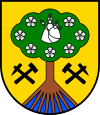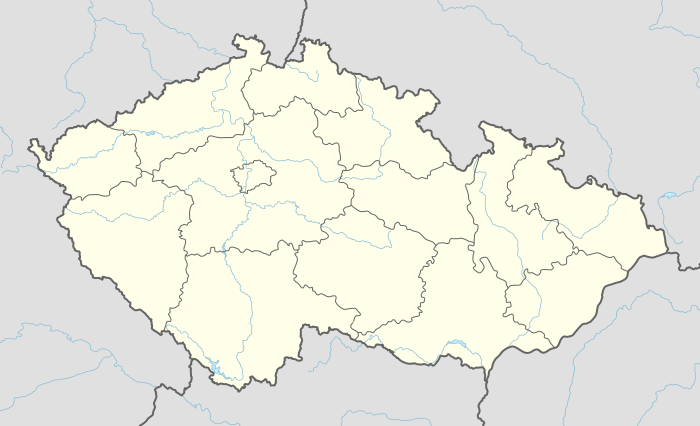Malé Svatoňovice
Malé Svatoňovice (Czech pronunciation: [ˈmalɛː ˈsvatoɲovɪtsɛ]; German: Klein Schwadowitz) is a village and municipality in the Hradec Králové Region of the Czech Republic at the bottom of Jestřebí hory, near the Krkonoše mountain range.
Malé Svatoňovice | |
|---|---|
Village | |
 Baroque church of Seven Joys of the Virgin Mary (1734) | |
 Flag  Coat of arms | |
| Nickname(s): Studánka | |
 Malé Svatoňovice Location in the Czech Republic | |
| Coordinates: 50°32′3″N 16°3′1″E | |
| Country | Czech Republic |
| Region | Hradec Králové |
| District | Trutnov |
| Documented | 1357 |
| Government | |
| • Mayor | Vladimír Provazník |
| Area | |
| • Total | 6.75 km2 (2.61 sq mi) |
| Elevation | 441 m (1,447 ft) |
| Population (2019) | |
| • Total | 1,504[1] |
| Postal code | 542 34 |
| Website | www |
As of 2018, the population of the village is 1,529, and the area is 6,75 km². There is a large railway station, built in the 1850s and enlarged during World War II for use in the coal mining industry.
Malé Svatoňovice is the starting point of many tourism trails. Places of geological interest in the area include the Hronov-Porici fault, abandoned mines, and exposed Permian-Mesozoic rocks.
In 1890, Malé Svatoňovice became the birthplace of Karel Čapek, one of the most famous Czech writers. There is a Čapek Brothers Museum in the village. Karel Čapek's brother Josef was the first Czech Cubist, and some of his work is displayed in the museum. Some locations in the village and surrounding areas were used by Karel Čapek in his book Nine Fairy Tales (also known as Fairy Tales), published in the United Kingdom in 1933.
Another author to use Studánka as the backdrop for her work was Božena Němcová, who mentioned Studánka as a pilgrimage destination in her 1855 novel The Grandmother (Czech: Babička).
In the central square of Malé Svatoňovice is a baroque Catholic church from 1734, dedicated to the Virgin Mary. The church was built on the site of seven strong springs. The springs now rise in the chapel, which was built in 1732. In the upper part of the village is a crossroads with seven chapels.
The village also used to be home to hydrotherapy spas, which are now closed.
References
- "Počet Obyvatel v Obcích - Population of Municipalities" (in Czech). Czech Statistical Office. p. 70. Retrieved 28 February 2020.
External links

- Postcards of Malé Svatoňovice
- Parish Male Svatoňovice